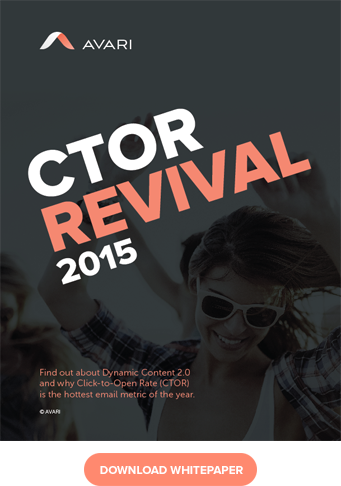
When tracking email marketing metrics, the open rate is indisputably one of the most important numbers to pay attention to.
However, when it comes to recipient engagement, the click-to-open rate (CTOR)—unique clicks divided by unique opens, multiplied by 100—can provide you with a much more relevant and informative approach to how well your content is performing. According to Loren McDonald at Silverpop, the CTOR “measures how effectively the content, design, and offers in your message are driving recipient clicks.”
We sat down with our Director of Customer Success here at AVARI, Nick Dijkstra, to determine how and when CTORs should be used and what they can tell us.
We’re hearing about CTOR with much more frequency these days. How new is this metric, and how essential do you think it is for email marketers?
It's been around awhile, and also referred to by some as the Effective Rate. For example, already in 2010, Hal Licino was talking about how the effective rate “provides significant insight into how your loyalty-based and retention processes are being received by your audience.” Even so, most tools and people in email marketing focus on click-through rates (CTR). They look at their list, or their audience, and see how many people clicked versus the total number of emails sent. They think, “Of those 100,000 people on my list, how many do I actually convert to our website, maybe even convert to a purchase?”
There are so many things influencing that number, from the quality of the list, to deliverability factors, relevance of content, and more. A big gatekeeper is also the subject line: if you don’t get the opens, you don’t get the clicks, even if your content is great. So by defining your success in terms of clicks, you might have a number that is not very effective in showing you how good your content actually is.
Can you give an example of what you mean by that?
Let's say that you're new to email marketing, or you haven't been doing it awhile. Let's say your list size is 100,000, and mostly it's people who don't really know who you are anymore, or it's been a long time, or they might not be used to you.
Whenever you start sending email campaigns again, your open rates might have dropped all the way to 15%, maybe 10%—even though you have very interesting content. You might have highly personal product recommendations, or you might have social content that's very engaging that people would love to see.
It's just that 90% of your list will not see it, and therefore will never click. If we're talking about calculating how effective your content in that email actually is, maybe we should only calculate it by the people who actually see the content. And by taking that 90% who never saw it into account, of course those numbers are going to be very low. It’s what Cara Olsen, the Director of Direct Marketing & eCRM at DEG, refers to as “a missed opportunity.” She explains it really well with this chart:
Compare this to a completely different list from another company that’s doing very well. You might actually have the exact same content in there. But just because the open rate, or maybe a subject line, is better than the other one, the click-through rates are going be influenced as well. And in those terms, I don't think those metrics alone are the right guide for marketers to understand how good their content is.
Meanwhile, if the subject line, layout, and graphics are the same, but the content different, using the effective rate can provide what email strategist Samantha Iodice referred to as “a clear percentage of how much more effective the messaging performed.”
How does the CTOR change based on the type of email that you send?
It depends upon the goal of the email. If your campaign is focused on getting click-throughs, getting people over to a specific location, or if it's just text, that's different. In an order confirmation email, it will show you that your order has been placed, it will be sent to you quickly, and there might not even be a link in there. Maybe one, to the website, but it's not specifically a goal because it's not a marketing email per se. (Side note: Transactional emails are a great low-hanging fruit opportunity for most businesses. CAN-SPAM allows for up to 20% of transactional email content to be used for marketing. But that’s a topic for another day.)
So anyway, CTOR definitely depends on the type of campaign—is it a promotional email, or is it a branding email? In those instances, one of the goals is usually to get someone to a specific location, either your website, or maybe your social sites. Especially if there is social content in campaigns, you might not be able to catch all those leads via the analytics tools that you're using for your website. People might end up on Instagram, or on Facebook, or somewhere else. In that case, it's very interesting to look at how the email is doing in terms of CTOR.
What determines what a good CTOR is?
In general, industry standards are always good to look at, like those outlined in Silverpop’s 2014 Email Marketing Metrics Benchmark Study or on MailerMailer. And you need to look at things like “How does my business compare to other businesses that are doing similar things?” If you're choosing to determine this by an industry benchmark, you're able to get closer to a similar audience. Then you can see if that is a good number or not, and compare it over time to your own campaigns to see if you're improving.
If you are using dynamic content like we offer at AVARI, you can also compare what you’re doing with static campaigns—you can see if personalized content really works for your business by comparing it to the static campaigns you sent before. That’s a great indicator.
What do the numbers tell us? What can you learn from your CTOR? How can you best analyze and utilize them?
We look at CTOR per dynamic content block in a campaign—there may be one, or there may be many. That allows our machine learning system to automatically figure out what works best, and inject better and better dynamic content every time.
As a marketer or agency running email campaigns, you can also think about the placement of the content in the layout. If you see that a CTOR is high on the upper area of the campaign, and gets lower when you go down toward the bottom of the email, it might be interesting to see what you can do if you change that around. In this case, the CTOR is a great measurement that tells us how effective individual pieces of content are.
For example, you could move the products higher up in the layout, and see how that influences the campaign results. Maybe it'll tell you that it was in the right place the first time, so you shouldn't have changed it, but that's how we learn. Test, test, test!
Additionally, Silverpop has a great list of suggestions for other ways to best use your CTOR.
How do CTORs work together with the AVARI product?
If you use one of our dynamic content blocks, we will show you per block how many impressions it got, how many people actually clicked on it. If you are in eCommerce, we also show you how many of the people who clicked made a purchase and how much revenue you earned. With our reporting, we're focused on getting that information to customers so they can improve, play around, shift those blocks, put them in different locations, and make more money.
What are examples of user stories where you changed things around to achieve better CTORs?
We work with people by supplying them with code or designs, and templates with dynamic content blocks. People like to go in and see how a campaign is doing the moment they send. I think we've all been there, where you send a campaign, especially a big one, and you just hit F5 over and over again and see those clicks and the revenue coming in—see what people are doing, how they're engaging with your email. We all want to see that success.
When customers were looking at the results in our reporting, they would see that the numbers were a little different from what they were seeing in their own ESP. What I've experienced is that people say “OK, that's all great, and I see that in the app that it was successful, I see that in my ESP it was successful, but I've seen different numbers. So why is that? Why is it different and what does that tell me?”
That's where I explain that we use CTOR as a better way to measure how successful their content is. Once people understand that, they usually just keep coming back to our app to see the growing value. That’s also very important for our customers to understand their success, because we not only show a revenue number; we help them be better marketers by showing them that specific content was very successful (or not). And even if their email list is not very good—we had some stale lists where people had not sent email marketing for a long time, so their open rates were not high—at least we can show them consistency in the CTOR numbers that we have and it makes a lot more sense.
If you had to teach someone in five steps how to best utilize CTORs, how would you do that?
I can do that in one step. Just send a campaign and compare your results to the industry, or to your last campaign. Just keep trying new things and see how it works, and if it's effective and if you get a high number, continue. It's all about comparing, and everything is relative. You have to compare your results to what you saw earlier, and that's where it is that this becomes interesting. If you care about creating engaging content that benefits your business, watch your CTOR!



